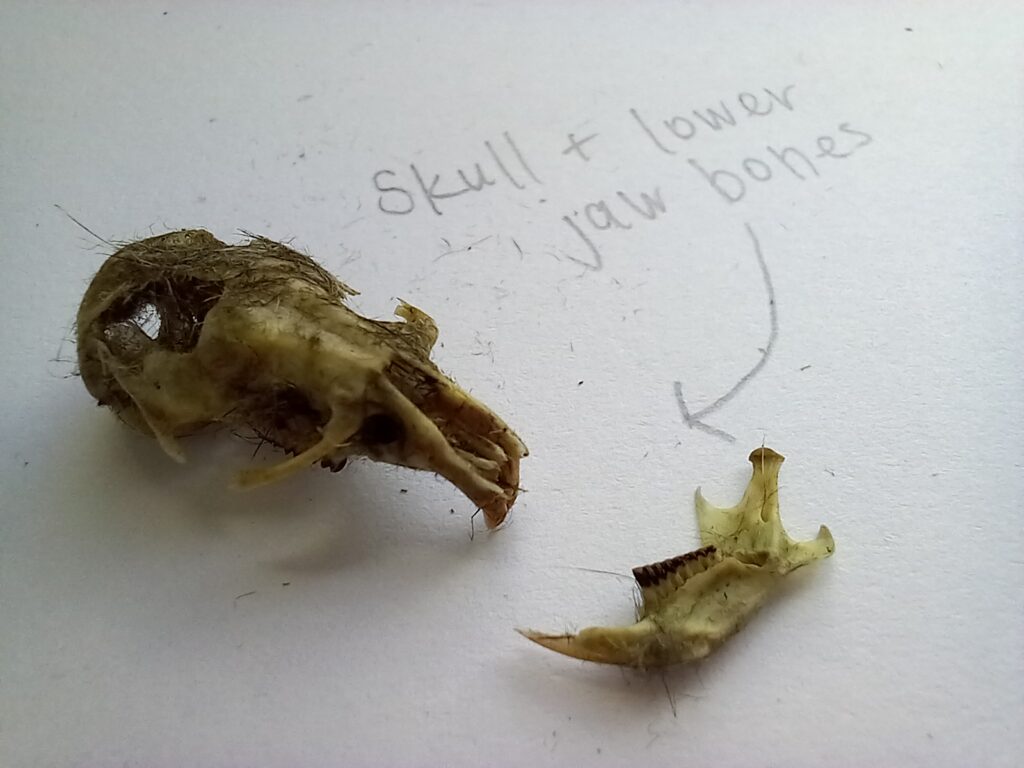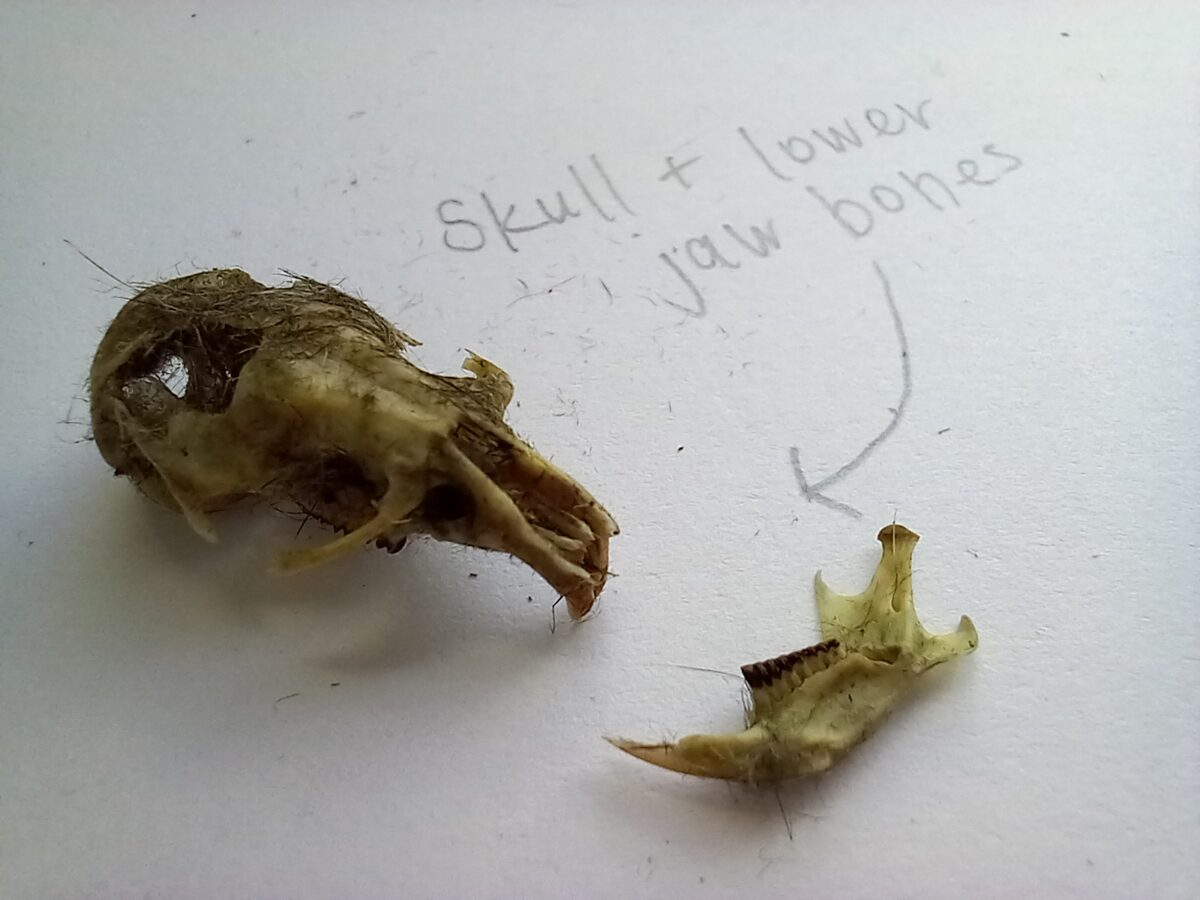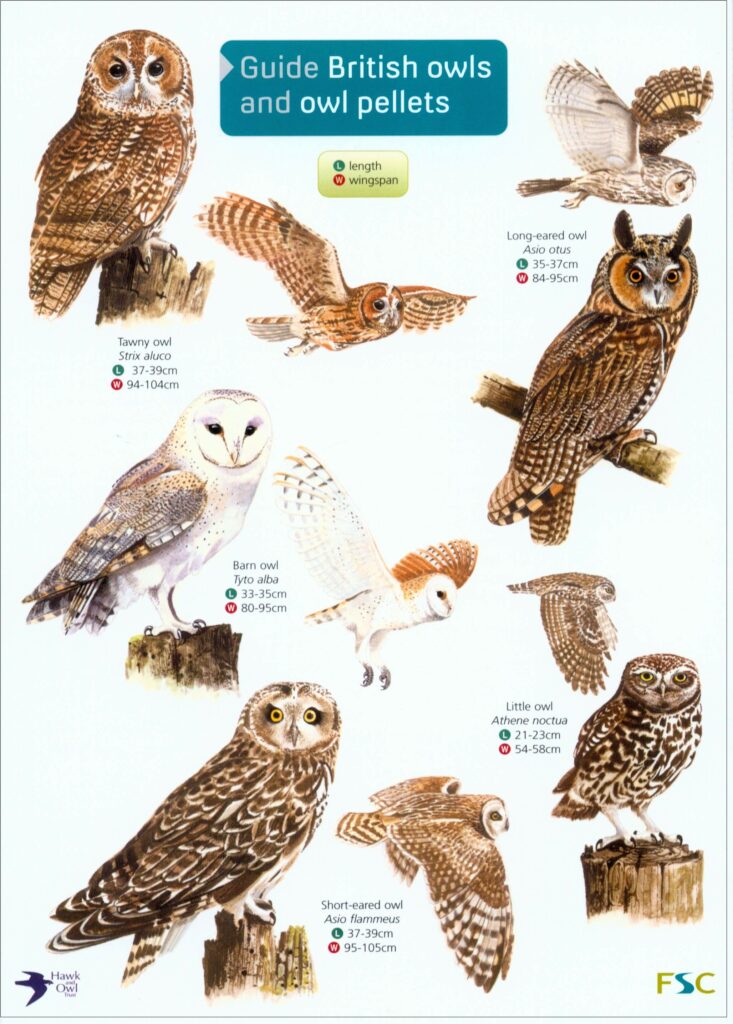
What is an owl pellet?
Owls feed on a variety of prey; most commonly small mammals but also birds, frogs and other small animals. These prey items are consumed in their entirety and, while the flesh is digested by enzymes, the owl is unable to digest the harder parts of the body, including the teeth, bones, fur or feathers. These indigestible parts are regurgitated as a pellet. Unless they are very fresh, pellets are dry, light and odourless.
In this article we will look at where to find owl pellets and how to tell which species of owl they came from. We will also provide some tips on how to dissect a pellet, how to group the bones into types, and how to identify some of the main species of small mammal that you will find in pellets in the UK.
Where to find owl pellets
Owl pellets can frequently be found wherever owls nest or roost. Good places to search are at the base of tall trees within woodland areas, or in barns or outbuildings where owls are known to roost. Please be aware that you must not disturb breeding or roosting owls in order to collect pellets. Barn Owls in particular are protected in the UK by law under the Wildlife & Countryside Act 1981 and their breeding sites must not be disturbed under any circumstances.
If you don’t have any luck finding your own pellets or don’t have access to places where you might find them, there are several places online where you can order some. Reputable sources in the UK include the Barn Owl Trust and the Suffolk Owl Sanctuary.
What species of owl is my pellet from?
There are five resident species of owl in the UK: Barn Owl, Tawny Owl, Little Owl, Short-Eared Owl and Long-Eared Owl. All of these species produce pellets that are relatively easy to tell apart, particularly if you also know the habitat where they were found. Below is a brief guide to their main characteristics.
• Barn Owl: pellets usually measure 3-7cm in length and are rounded at both ends. They are fairly dark in colour and have a smooth surface.
• Tawny Owl: pellets measure 2-5cm in length and are narrow and bumpy, often having tapered ends. Greyish in colour and sometimes furry looking.
• Little Owl: pellets are fairly small measuring only 1.5-2cm in length. Long and narrow with a soft crumbly texture.
• Short-Eared Owl: pellets are fairly large, measuring 3-6cm in length. Narrow with one rounded end and one tapered end. They are grey and smooth and very lightweight.
• Long-Eared Owl: pellets measure around 2-4cm and are narrow and bumpy. Usually grey in colour.
The most common pellets you will find in the UK are from Barn Owls.

How to dissect an owl pellet
There isn’t much equipment you need to dissect an owl pellet, but a few items will make the job a bit easier:
• Mounted needle: this is useful for teasing out fur from around the bones, and moving around delicate specimens. A cocktail stick or needle pushed into a cork will also do the trick.
• Forceps/tweezers: helpful for picking up bones and particularly for removing fur from inside skulls. Forceps with a fine point are best.
• Magnifying glass/hand lens: a small magnifier will allow you to get a closer look at the bones that you find. Jaw bones in particular are very useful for identifying the species and a magnifier will help you get a better look at the arrangement and structure of the teeth.
• White paper/card and glue: it can be helpful to arrange your bones by type onto a sheet of white paper which you can then write on when you have decided what they are and who they belong to. If you would like to make a permanent ID aid you can also glue them onto a piece of card and add permanent labels.
How to identify the contents of an owl pellet
The first thing you will need to do is to tease apart the pellet and separate the bones from the fur and feathers that are holding it all together. To begin with it is easiest to gently break the pellet into several smaller sections then work on each of these in turn. Use your fingers as well as the forceps to carefully tease apart each section, removing any bones and placing them to one side for identification. If your pellet is very hard and dry, try soaking it in water first to soften it.
Once you have all of the bones from your owl pellet, try to group them into types on your sheet of paper. The most common bones you will find are the following:
- Skulls: for mammals, this consists of the top part of the skull and upper jaw, along with the lower jaw, although this is likely to become detached once you have cleaned all of the fur and other material from inside. For bird species this will include the upper and lower parts of the beak.
- Back legs: includes the thigh bone (femur) and the lower leg bones (fibula and tibia)
- Front legs (arms or wings): includes both upper (humerus) and lower (radius and ulna) bones
- Hip bones
- Shoulder blades (scapula)
- Back bones (vertebrae)
- Ribs
The image below illustrates typical examples of each type of bone. You can also download a useful bone identification sheet from the Suffolk Owl Sanctuary website.

 The most useful part of the skeleton for identification is the skull and jaws or beak. Bird skulls will obviously be very distinct from those of mammals due to the presence of the beak, so these can immediately be separated out. For the remaining mammal skulls, however, we will need to take a closer look at their lower jaw bones and teeth.
The most useful part of the skeleton for identification is the skull and jaws or beak. Bird skulls will obviously be very distinct from those of mammals due to the presence of the beak, so these can immediately be separated out. For the remaining mammal skulls, however, we will need to take a closer look at their lower jaw bones and teeth.
In the UK the most common small mammals you will find in owl pellets are voles, mice and shrews. It is very easy to distinguish which of the lower jaws belong to shrews as they have a continuous line of teeth from the front to the back of the jaw. This is because shrews are insectivores and chew their food, much the same as we do. Voles and mice, however, both gnaw their food, and have a big gap between the long front tooth and the back teeth.
To tell the difference between voles and shrews, we need to take a closer look at their back teeth. Voles have teeth with distinctive grooves down the sides. In those of a field vole, the grooves run all the way down the side of the tooth. There is also no obvious root. Bank voles have grooves which only run part-way down the side of the tooth and they have two obvious roots, similar to those of a human tooth. The back tooth from a mouse jaw is much smaller when compared to a vole and its structure is much more similar to that of a human tooth. It also has two roots. This sheet from the Barn Owl Trust has a great illustration of the various small mammal lower jaws with size guidelines to help with identification.

Hopefully this article has been a useful introduction to owl pellet dissection and the identification of some of the most common prey species contained within them. If you want more help with identifying all of the bones in your pellet down to species level, the guides listed below are invaluable. Once you have categorised all of the bones you can attach them to a piece of card with permanent labels or arrange them to create a complete skeleton of each species.
Finally, don’t forget to wash your hands well when you have finished your dissection. Any pellet remains can be safely composted.
Further reading
Guide to British Owls and Owl Pellets
This fold-out chart includes colour paintings of the five species of owl permanently resident in the British Isles, shown both perched and at rest. Also included are illustrations and written descriptions of the different pellets that may be found, and a systematic identification key to their contents, including complete skulls, jaws, teeth and other recognisable bones and animal parts.
This booklet will not only enable you to identify what you find in the pellets of British owls, but also shows how the data may be usefully presented and how to estimate the actual weight of food the birds have eaten.



